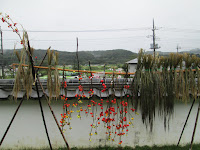On Sep.22, a national holiday known as Autumnal Equinox Day in Japan, I went to Kinchakuda in Hidaka city together with my friends of high-school days, to see five millions of Lycoris radiata blooming along the Koma river. The red carpet of Lycoris was brightly shining in a drizzling rain after the seasonal typhoon No.16 hit the region.



Hidaka city is located around 70 km northwest to the center of Tokyo. 1300 years ago the people from the current North Korea, then Koguryo, came to Japan as immigrants or refugees and gathered in 716 AC in then Koma county, a part of which is the current Hidaka city. The nearby Koma shrine worships a suspected member of the Koukuri royal family as a God.
After strolling around the Lycoris park, we visited an old farmer’s house which was built more than 100 years ago. The Arai family had been the head of the village for generations since the Edo era through Meiji era. The second floor of the house had been used to raise silkworms. Viewing the distant hill over the tile-roofed earthen wall in the garden, I realized Autumn coming at last.



An anecdote about Lycoris
One of my friends who is passionate about learning Korean culture, introduced us an anecdote about Lycoris radiata in her email on the next day. Let me cite her story. It describes well the nature of this flower and the mentality toward them which is shared among Japanese and Korean people;
"According to a local people, 'Now is the time to appreciate its beauty of flowers, but in December we will see the leaves growing thick all over the ground, which is also a spectacular view'.
In Japanese, Lycoris radiata is called as Higanbana (彼岸花) with an alias of “曼珠沙華“. In Korean it has also an alias of “相思華“, which is used as a word to represent autumn in Japanese Hike, a poem in seventeen syllables having a 5-7-5 syllabic form.
This “相思華“ is literally translated into “Leaves ponder over its flowers, and flowers ponder over its leaves”, meaning that with leaves and flowers both stemming from the same root, they will never meet each other.


No comments:
Post a Comment